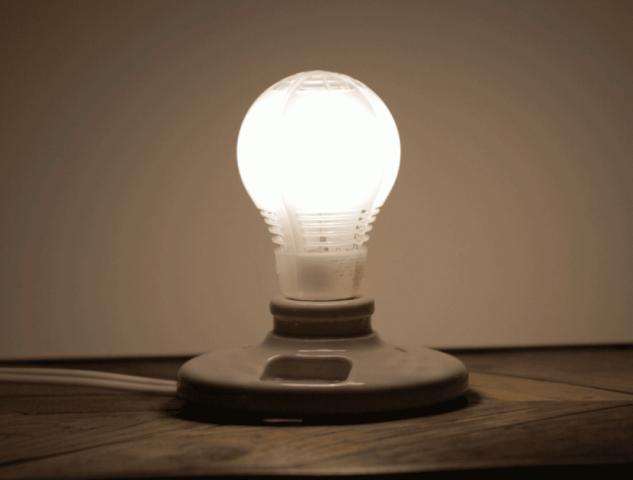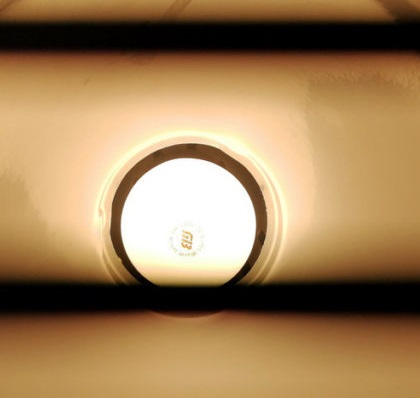Categories: Featured Articles » Sources of light
Number of views: 2756
Comments on the article: 2
Ripple and flicker of LED lamps and other light sources
The current popularity of LED light sources used in everyday life, at manufacturing enterprises and in street lighting systems, is explained by their many advantages: efficiency, environmental friendliness, and another important property - minimal pulsations of the emitted light. Let's look at this aspect in more detail. Why is the nature of the pulsations of the light flux so important for people?
At all times of the existence of human civilization, the Sun has always remained the main source of light on earth. At night - the moon. But it was the sunlight of the eye and the human nervous system that learned to perceive more comfortably than even light from a fire, a lamp or a candle, and even more so from other specially created sources.
A person’s need to conduct an active and productive life activity in the dark, forced him to look for alternative light sources. And to this day, we have come to the point that we cannot imagine life without electric lamps, lamps, spotlights, etc.

The first electric light sources were arc lamps, then incandescent lamps gained popularity. Their soft yellowish light was very similar to the sun in color temperature. However, the economic effect left much to be desired, since incandescent lamps actually warmed the surrounding air more than illuminated the space. The cost of such lighting was great.
On the effect of pulsating light flux on health
Energy-saving lighting devices have given us the opportunity to get cheaper light and save energy. However, fluorescent lighting was not so safe. Scientists conducted studies of luminous flux fluorescent tubes, which showed that their luminous flux has incredibly high pulsations, which are harmful to human health.
Improving the ballast equipment of fluorescent lamps allowed only 40% to reduce the ripple of their light, but this is quite a lot - the overall ripple coefficient could not be reduced to less than 15%. For kindergartens, work rooms, industrial premises - this is still unacceptable.
Current norms of pulsations of the light flux (according to the regulations of SP 52.13330.2011, SNiP 23-05-95 "and SanPiN 2.2.1 / 2.1.1.1278-03) are considered as such:
-
for rooms where work is carried out requiring increased accuracy, as well as for rooms where there is a tendency to a stroboscopic effect and for kindergartens - up to 10%;
-
for rooms where people work with computers - up to 5%.

These restrictions associated with strict requirements for the pulsation coefficient are not limited only to the impact on the nervous system of people. In some places, the stroboscopic effect can create the illusion of the safety of a working machine: when the part rotates, it may seem to the worker that it is stationary, there is a risk of serious work injury. This happens when the frequency of pulsations of light coincides with the frequency of rotation of the part. This stroboscopic effect is appropriate at the disco and seems very interesting, but in serious working conditions it becomes dangerous.
Speaking about the influence of pulsations of light on the human nervous system, we can mention that incandescent lamps give a frequency of more than 25 Hz, the human eye does not perceive at all, but the body still, though unconsciously, perceives it.
Ripples act through the retina of the eye on the brain and central nervous system. A person may experience a headache, deteriorate mood and well-being, decrease working capacity, sleep disturbance may develop, etc.And only with a light pulsation frequency of more than 300 Hz there will be no harm to the human nervous system at all - physicians have come to this conclusion in their studies.
Of course, all electrical light sources flicker in one way or another. An incandescent lamp at best has a ripple factor of 15%, and this is not felt by us because the effect is weak, because only 10% of the energy goes into the light, the remaining 90% goes into heat. From the point of view of pulsations, fluorescent lamps, with their 15% and high efficiency, are most harmful. But high-quality LED lamps have ripples at only about 4%. They can be placed everywhere, even in children's rooms and in offices with computers. See also - How to distinguish a bad LED from a good LED

Miser pays twice
Almost led lamps equipped with driverswhich provide LEDs with almost perfect direct current. As a result, the best LED lamps have pulsations of less than the maximum allowable rate. However, not all LED lamps are perfect. Wanting to make the product cheaper at cost, some manufacturers do not disdain installing a simple control circuit in an LED lamp, and buyers peck at a low price.
In such low-quality LED lamps, ripple can exceed 45%! Maybe this indicator will soar to such a high value not immediately, but after several months of operation of the lamp, but if the driver is of poor quality, then this is very likely to happen sooner or later, and the LED lamp will become harmful to your health.
Do not skimp on good LED lamps from well-known trusted lighting manufacturers. And if it is possible to check the ripple factor, then be sure to do it, because in any batch of lamps there are no, and marriage can get caught.
How to check light source ripple
To check the pulsation coefficient of the light flux of any lamp, including an LED, you can resort to one of the simple methods that allow you to detect ripples if their frequency is less than 100 Hz. The first and easiest way - try to photograph the lamp on the camera of your smartphone. If the image flickers when you hover over the lamp, this means that the lamp has a significant ripple coefficient. A photograph of such a lamp will have dark streaks.

The second, more intricate way is to point the lamp at the blades of a working fan. If there is an illusion of stopped blades - the lamp has significant ripple.
Another way is to spin a spinning top with radial stripes printed on it with a black marker under the light of the lamp. If the stroboscopic effect manifests itself, clearly increased pulsations take place.
Ripples with a frequency of more than 100 Hz will help to identify light meter with ripple factor measurement function.
Conclusion
Use high-quality LED lamps, with them your health and performance will always be at their best. And do not forget to get enough sleep. Remember that once purchased, albeit relatively expensive, but high-quality LED lamp will last for many years and will definitely pay off not only in monetary terms, but also by the measure of your own productivity.
Modern LED lamps: what to look for when choosing
Choosing the type of lamp for domestic lighting - which is better for health?
See also at bgv.electricianexp.com
:
